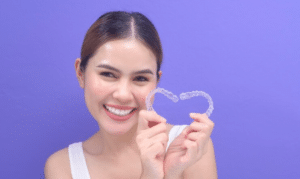Clear aligners have come a long way to meet the rising demand, with constant improvements in materials and production techniques. This progress has broadened the range of cases that can be effectively treated using clear aligners. Not only do these aligners provide patients with a treatment experience that is both visually appealing and comfortable, but they also support good oral hygiene. Compared to traditional braces, clear aligners cause less discomfort, reduce the need for frequent and lengthy appointments, and result in fewer emergency visits. In this article, we’ll explore the positive impacts of clear aligners on oral health and cover everything you need to know about this procedure.
Understanding Clear Aligners
In recent years, more adults are seeking orthodontic treatment, preferring aesthetically pleasing and comfortable alternatives to traditional braces. In 1946, Kesling introduced the idea of using clear overlay appliances to gradually improve teeth alignment. In 1997, Align Technology made a big leap, modernizing orthodontics and introducing clear aligner treatment (CAT), making Kesling’s concept a practical option (Rossini et al., 2015). Align Technology’s clear aligner system, introduced a few years ago, is now widely preferred by adults due to its improved aesthetics and comfort compared to traditional fixed appliances. Ongoing enhancements have significantly improved clinical outcomes, as shown in various case reports.

The Biomechanics of Aligner Treatment
Clear aligner systems based on production methods can be broadly classified into two types: those crafted from thermoplastic materials through manual setup and those utilizing CAD-CAM technologies for design and production. The mechanics of tooth movement with clear aligners can be elucidated from two distinct perspectives: the displacement-driven system and the force-driven system. The displacement-driven system predominantly governs straightforward movements such as tipping or minor rotations.
Aligners are shaped based on the anticipated position of the tooth in the subsequent stage. It guides the tooth’s movement until it aligns with the corresponding aligner. This system is acknowledged for being less effective in controlling tooth movement, particularly in producing root movements. In contrast, the force-driven system leverages biomechanical principles to facilitate tooth movement. Aligners are meticulously designed to exert specific forces on the teeth. It is important to note that the shape of aligners for generating these forces may not necessarily mirror the natural tooth shape. While achieving the extrusion of a single tooth is moderately challenging with clear aligners compared to fixed-appliance systems, supplementary tools like buttons and elastics can be employed to ease this movement. Furthermore, clear aligners can successfully facilitate the extrusion of a group of teeth, such as maxillary incisors (Tamer et al., 2019).
Effects of Clear Aligners on Oral Health
The utilization of clear aligners plays a pivotal role in enhancing oral hygiene, leading to improvements in periodontal health and a subsequent reduction in key indicators such as plaque levels, gingival inflammation, bleeding upon probing, and pocket depth. Beyond the promotion of oral hygiene, clear aligners also contribute to diminishing plaque accumulation and mitigating the formation of white spot lesions.
White spot lesions (WSLs) manifest as opaque, milky white areas on the smooth surfaces of teeth during the early stages of caries. Braces often increase white spot lesions (WSLs) due to poorer oral hygiene and more plaque buildup. The removable nature of clear aligners has streamlined oral hygiene practices, resulting in a decrease in the occurrence of WSLs. Clear aligner users can easily maintain dental hygiene by cleaning their teeth and aligners whenever convenient, as plaque buildup is a key factor in gingivitis. As a result, it helps in effectively eliminating plaque biofilm (Tamer et al., 2019).
Clear aligners exert regulated intermittent forces throughout the treatment duration, allowing for specific intervals that support the rebuilding of the periodontal membrane. Clear aligners are preferred by both practitioners and patients for their convenience, comfort, and positive impact on periodontal health. In recent studies, clear aligners have demonstrated commendable vertical control, challenging the conventional notion of limitations in addressing specific orthodontic issues. Notably, clinicians have reported successful treatments for open bites characterized by high mandibular plane angles. This success is attributed to the incorporation of intrusive forces and leveraging the plastic material thickness between the teeth. It eventually allows for effective management of open bite cases without the need for posterior teeth extrusion (Garnett et al., 2019).
The advent of clear aligners has marked a transformative era in orthodontic care, significantly impacting oral health practices. With an increasing number of adults seeking orthodontic treatment, the demand for esthetic and comfortable alternatives has become more apparent. This advanced orthodontic treatment not only aligns with the desire for discreet and convenient options but also aligns misaligned teeth with precision, promoting improved oral health. As technology continues to evolve, clear aligners stand as a testament to innovation in the field, offering individuals a viable and effective means to achieve optimal oral health and a confident smile.
Reference List
– Tamer, İ., Öztaş, E., & Marşan, G. (2019). Orthodontic treatment with clear aligners and the scientific reality behind their marketing: a literature review. Turkish journal of orthodontics, 32(4), 241.
– Garnett, B. S., Mahood, K., Nguyen, M., Al-Khateeb, A., Liu, S., Boyd, R., & Oh, H. (2019). Cephalometric comparison of adult anterior open bite treatment using clear aligners and fixed appliances. The Angle Orthodontist, 89(1), 3-9.
– Rossini, G., Parrini, S., Castroflorio, T., Deregibus, A., & Debernardi, C. L. (2015). Efficacy of clear aligners in controlling orthodontic tooth movement: a systematic review. The Angle Orthodontist, 85(5), 881-889.



